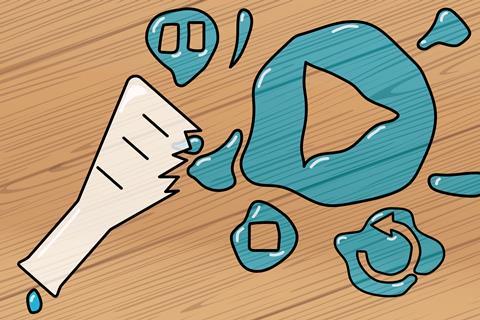The next time things go awry in the lab, raid your video library for an unexpected learning opportunity
I’ve had demonstrations go wrong more times than I can count. Some were nerve-wracking, such as when the boiling tube shattered during a cracking demo, or when (more than once) my thermite demo didn’t go first time; some were mysterious, and I still don’t have good explanations; and others were frustrating as I tried again and again, often babbling on at my students to distract them from boredom. Over time, though, I have learned a few strategies for managing the moment, panicking less and even finding ways to push students’ thinking forward.

Planning for when it goes wrong
Clearly, practicals and demonstrations don’t always work as anticipated, and switching to a video can ensure that students can still make practical observations and link them to theoretical ideas. However, the least ideal classroom scenario is: (1) attempting a demo, (2) the demo going wrong and (3) spending the next five minutes scrambling on YouTube for a decent enough video that doesn’t lead to any student misconceptions about what you are intending them to learn, while (4) the abandoned demo is festering on the bench and (5) students are losing patience. Nightmare.
So, preparation is key: link videos for each practical and demonstration to the scheme of work, so a video you are confident about is just one click away. Adding these links doesn’t have to be a time-consuming endeavour; you can add links one topic at a time during department meetings. In my experience, my colleagues possess a wealth of knowledge on great videos, and so updating the scheme of work together is quick and very thorough.
Check out the latest practical videos for both 14–16 students and 16–18 students.
Switching from demo to video
You are ready: a video is available for any eventuality. But it can still be challenging to manage the moment when things go wrong. The most important thing, of course, is not to panic. I know that’s unhelpful advice, so here are some things to do instead of panicking.
Ask students to return to their seats, open their notes, and pick up a pen ready to make notes on the video. You have two options: both require students to watch the video closely, probably twice. This will mean you have a few minutes to clean up the failed demonstration, or at least make sure it is safe and out of the way (and calm any frazzled nerves).
Option 1: Maintain the learning focus: the content/practical skills you were intending to teach (stick to Plan A). This means the students will make notes on the video in the same way they would have for the demo.
Option 2: Switch the focus to hypothesising about what went wrong. Dan Beech argues that letting students get it wrong in practical work is beneficial for developing their skills in analysing, interpreting, evaluating, drawing conclusions, designing and redesigning practicals. The same goes for when demos go wrong. By focusing students’ observations on how the video differs from the failed demonstration, students can develop hypotheses about why they didn’t observe what was expected.
To do this in the moment, ask students to divide a page into quadrants labelled with the headings: apparatus, chemicals, method/sequence, and observations. Then ask them to describe what happened in the failed demo using the four boxes. While students are watching the video, they can add more notes to each quadrant. Finally, they can identify the differences, decide which are relevant and develop plausible explanations for why the demo didn’t work as intended. This works particularly well if students use different colours for the failed demo, the video and the possible explanations.
You can discuss the differences, debate possible explanations and potentially even agree on what went wrong. After this, you can always come back to Plan A if necessary but prepare to be surprised by how far students’ thinking has moved on.
So, next time you have an unanticipated explosion, bizarre-looking product or no observable product, raid your video library, and leverage the momentary mystery of chemistry for a rich, albeit unexpected, learning opportunity.
Emily Rose Seeber
Additional information









No comments yet